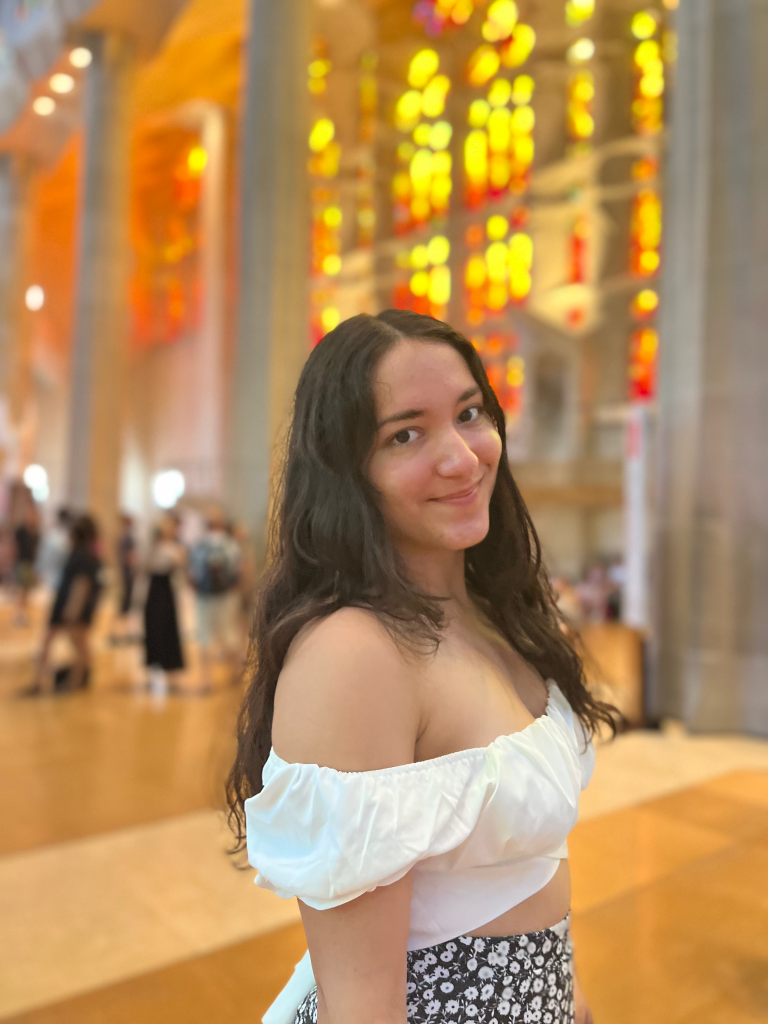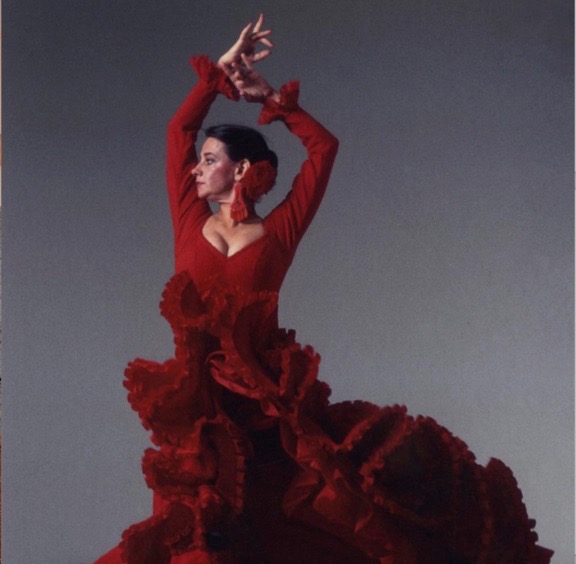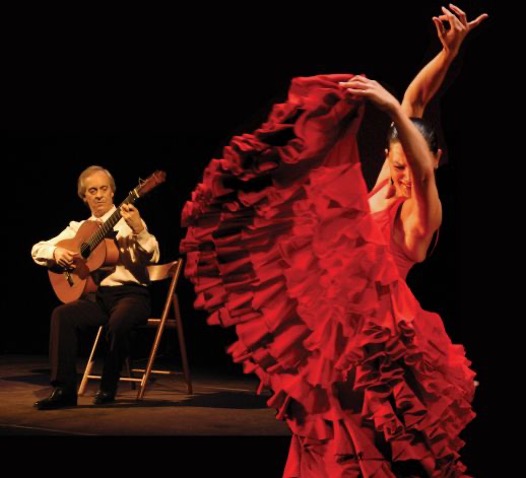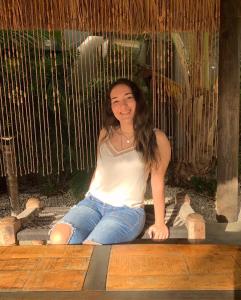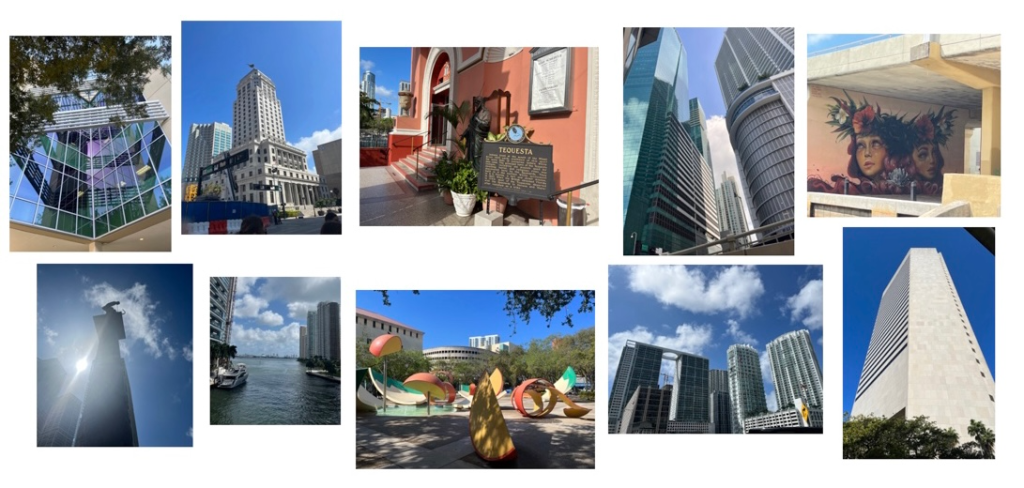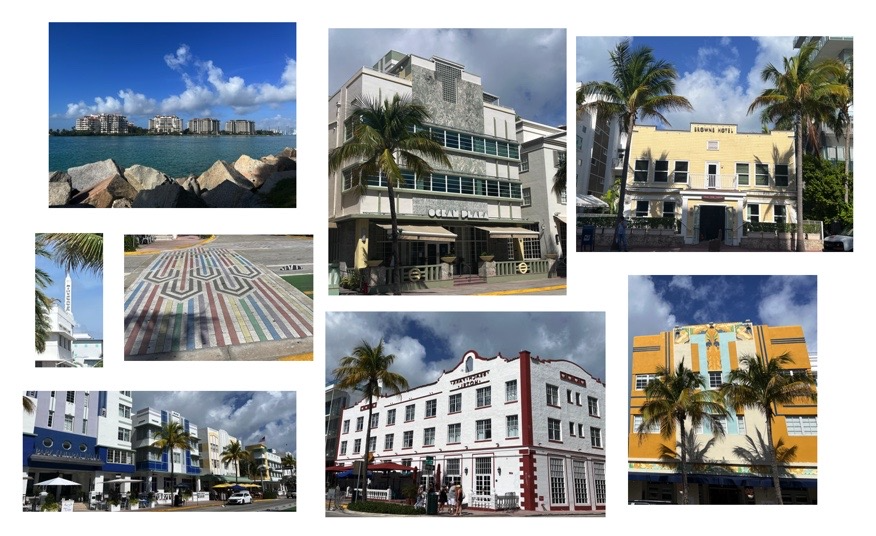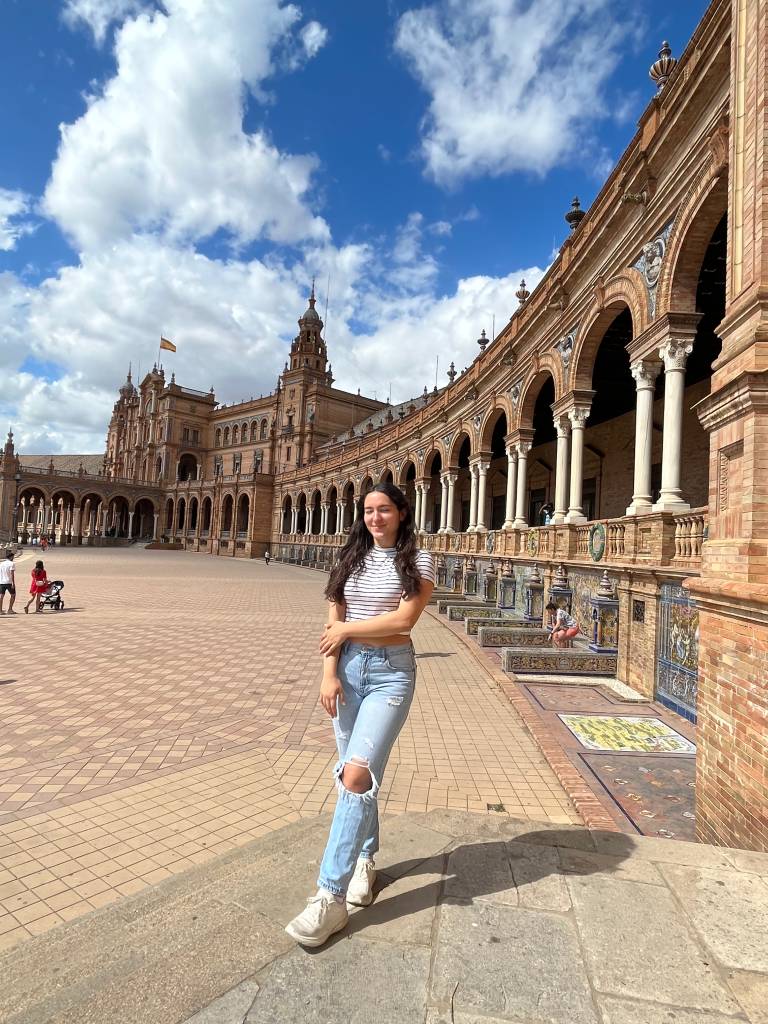
Leah Daire is a Biology undergraduate student at Florida International University (FIU). Once she graduates, she plans to attend medical school. She is involved in the Peer Led Team Learning (PLTL) program at FIU and the organization Panthers Uniting in Support of Health (P.U.S.H.). She has a large family who come from Cuba and Lebanon, however, she was raised primarily under the Cuban culture. She loves reading, jogging, bike riding, and pets.
……………………………………………………….
Madrid as Text

Images taken by Leah Daire (CC by 4.0)
“EL retiro de hoy”
🌳📚🌳
By Leah Daire of FIU in Madrid in June 2022.
El Retiro park is a central point of life in Madrid. Walking through, many people are enjoying their time with their family or friends. Some of my classmates and I had a picnic at the park one afternoon, where we sat on a blanket and talked about our time so far in Madrid. Another morning, we walked through the garden in matching dresses and had a mini photoshoot. This park is a place for many in this urban city to come enjoy nature and relax. Without it, in my opinion, the city would lose an integral part that makes it a great city to live in.
However, El Retiro did not begin as a sanctuary open to everyone. In the 17th century (officially opened in 1633), the park was made by Philip IV for royalty. It held a large palace and surrounding gardens. These were severely cut down in the 19th century during the Spanish war of Independence. The resulting structures was a war ground with stand-alone walls, small rooms, and ruins. In the 18th century, Carlos III renovated it as part of his many alterations to the city of Madrid. He loved the park and could often be found escaping the city in there. Finally, in 1868, the Spanish government gave the lands to the city of Madrid. El Retiro was established as a public park to promote good behaviors in an urban city. In order to generate funds, buildings within the park were sold. Some of the buildings are used to hold cafes and bar which are used by the people while they spend their time in the park.
One of the entrances to the park holds a “Book Fair” called Cuesta de Moyano. It is a permanent fixture in the park with booksellers displaying old Spanish texts. Paintings and other items can also be found there. This tradition officially started in 1925 with wooden stands. However, before this, vendors would sell books in the restroom near the current location of the book fair. This is just one of the many important locals found in El Retiro, but as it is my favorite, it is the one I will mention.
In 2021, the park became part of a larger project named the Landscape of Light, which includes El Retiro and el Paseo del Prado. This Landscape of Light was named a UNESO World Heritage Site. An honor which designates the importance of the park not only in the culture of Madrid, but around the world. El Retiro is a model example of how to complement an urban center with nature. It is important to have a place for people to stroll through gardens and lay beneath the trees.
References
Alberto Romero. (2019). A Walk Through the Mysteries and History of El Retiro. Periergeia.
Ayuntamiento de Madrid. (2018). Historia de El Retiro. Madrid. https://www.madrid.es/portales/munimadrid/es/Inicio/Buscador-Simple/Historia-de-El-Retiro?vgnextoid=7c001d15ba89d210VgnVCM2000000c205a0aRCRD&vgnextchannel=8db7566813946010VgnVCM100000dc0ca8c0RCRD#
The Editors of Encyclopaedia Britannica. (2020). Retiro Park. Encyclopaedia Britannica.
https://www.britannica.com/place/Retiro-Park
Madrid Destino Cultura Turisomo y Negocio. (2022). Librerías de la Cuesta de Moyano. Pagina Oficial de Turismo de la ciudad de Madrid. https://www.esmadrid.com/informacion-turistica/librerias-cuesta-moyano
……………………………………………………….
Segovia as Text
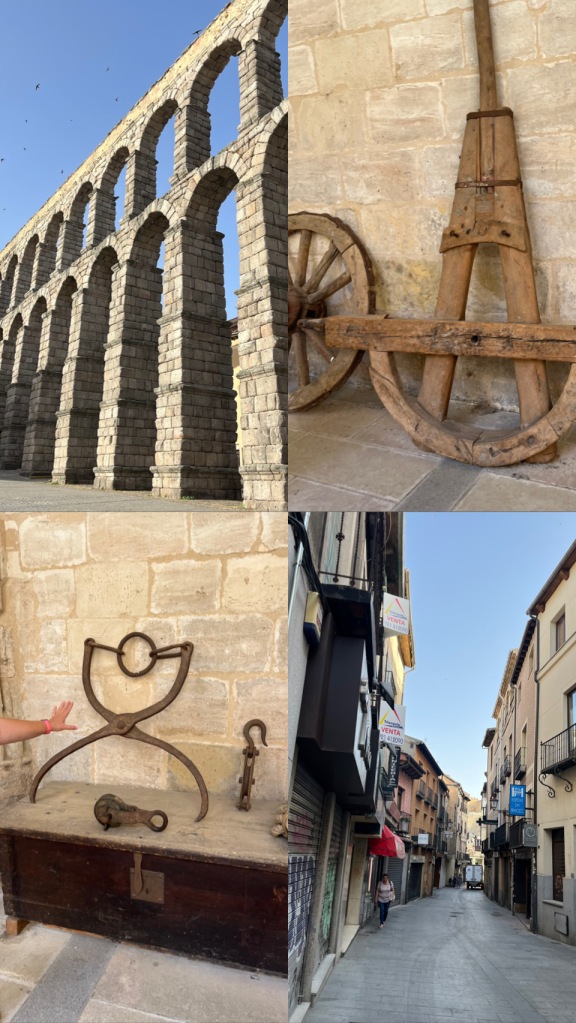
Images taken by Leah Daire (CC by 4.0)
“Construction of the aqueduct”
🧱💧🧱
By Leah Daire of FIU in Segovia in June 2022.
When stepping of the bus in Sevilla, we were greeted to the site of a massive stone structure, almost 95 feet tall – it is the aqueduct of Segovia. Although the section we were seeing is the tallest part, the structure stretches miles in both directions; it leads from the mountains to the palace in the center of the city.
Segovia has two rivers nearby, however, the water from these rivers is somewhat dirty. As such, the aqueduct was built, to bring clean water from the mountains. Although the exact date of construction is unknown, it is estimated that the Romans built the aqueduct in the year 117. It must have taken about 20 years to construct. The exact date is unknown as the sign letters that provided that information were deemed dangerous and as such were removed in the 1520’s.
The stones were made by stone masons right at the moment of construction with given dimensions. In order to stack the stones on to of each other, they were picked up with giant forceps. They had a large mark to help with proper orientation (as well as to support the wooden scaffolding used for building). The columns each had horizontal lines as a sort of decoration. These lines had another purpose, however, and that was to make the pillars seem more uniform in height. Finally, to add the arches, simbras, or large wooden structure used to support arches during construction, were used. Once the keystone was placed in, the umbras were removed, making the arch complete.
There have been more recent additions, one in which was to increase the amount of water flow in the 1500’s. It is note-able that the structure itself was built with several basins to slow the water flow and make sure water did not flow over the edge.
The aqueduct itself was used until 1973. At that time, the water was only used for a few things, such as agriculture. As it was used until recently, the aqueduct has been well preserved (unlike most aqueducts world wide). This is a very beautiful structure, one that is difficult to have imagined was built when it was.
References
Now. (2020, December 18). Why Segovia Stands Out Among Roman Aqueducts as an Engineering Marvel. Northrop Grumman. https://now.northropgrumman.com/the-aqueduct-of-segovia-ancient-engineerings-high-water-mark/
Stamper, P. (2021, May 20). Segovia Aqueduct. History Hit.
……………………………………………………….
Sevilla as Text
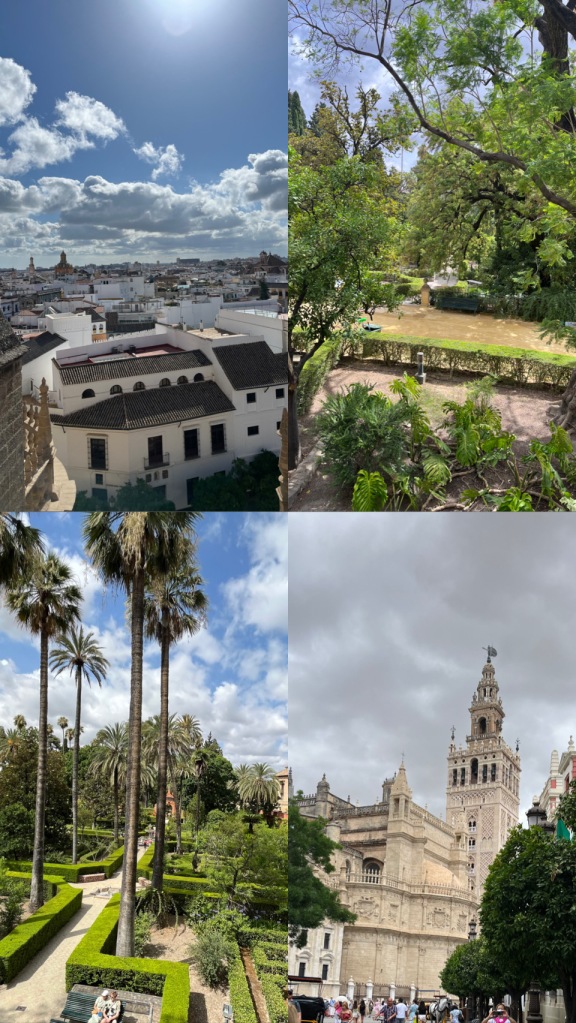
Images taken by Leah Daire (CC by 4.0)
“Green Zones”
🪴🚙🪴
By Leah Daire of FIU in Sevilla in June 2022.
One day in high school, I was looking out the window and I saw an orange haze over the horizon. My class crowded around the window to see what it was covering the buildings in the Brickell skyline; it was photochemical smog (which results when chemicals in the air combine with sunlight). One of the major pollutants that contribute to this smog is car exhaust.
In Sevilla (as well as other areas of Spain) there is environmental zones to help with this issue. The one is Sevilla specifically is a temporary Low Emission Zone. It was established in 2018.
During times of high pollutant density in the air, cars that are un-environmentally friendly are not allowed to drive through the zone. If they pass through, they have to pay a 90€ fine. This is a measure to keep the level of pollutants at a moderate level. In addition, certain vehicles are not permitted to drive through the zone at all.
Green zone stickers are used to designate if the car is a low-emitting vehicle or not. The green zone app is used to track whether or not a vehicle can drive through the area at a certain time.
Photochemical smog can cause a number of health concerns (as well as wear away at certain materials). One such problem is an increase of heart conditions. I have a family member who recently passed from a heart attack and to hear that Spain is doing something to help combat the various health issues that photochemical smog can cause is very beautiful news. Reports from the World Health Organization state that about 7 million people die each year from air pollution around the world. As a (hopefully!) future doctor, this is concerning to hear. The US does not have any mandatory low emission zones, unlike many countries in Europe. However, there are some voluntary ones that are showing promise.
References
Anderson, M. (2021). Photochemical smog: what is it, causes and consequences. AgroCorn. https://agrocorrn.com/photochemical-smog-what-is-causes-and-consequences/
Distintivo-ambiental.es. (2020). The LEZ Seville environmental zone. Distintivo-Ambiental.es. https://www.distintivo-ambiental.es/en/spanish-environmental-zones/sevilla-lez.html
Green-zones.eu. (2022). Green-zones.eu. Green-zones.eu. https://www.green-zones.eu/en/
Tomorrow’s World Today. (2022). Everything You Should Know About Low Emission Zones.Tomorrow’s World Today. https://www.tomorrowsworldtoday.com/2022/06/13/everything-you-should-know-about-low-emission-zones/
World Health Organization. (2022). Air Pollution in the Western Pacific. World Health Organization. https://www.who.int/westernpacific/health-topics/air-pollution
……………………………………………………….
Granada as Text
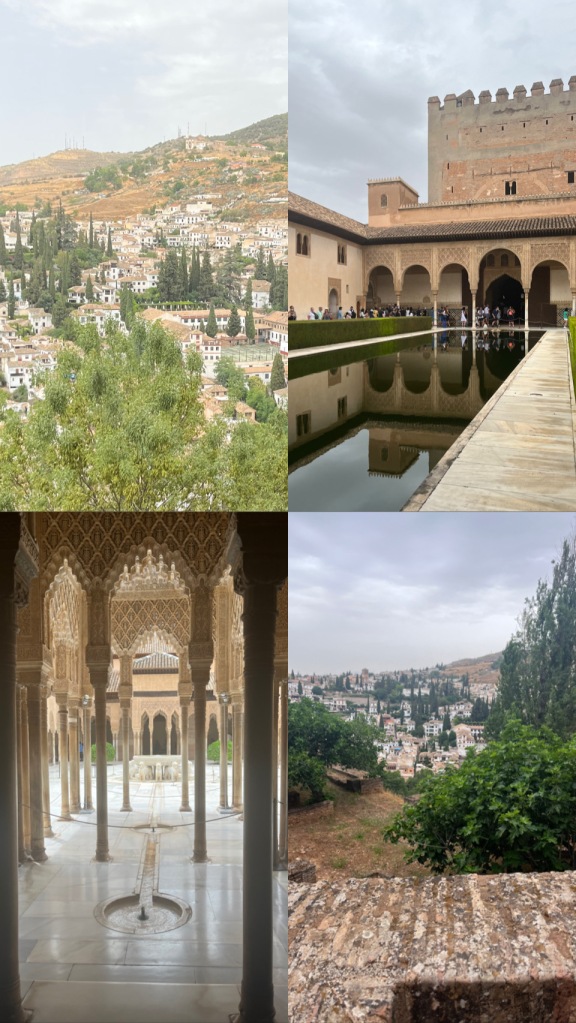
Images taken by Leah Daire (CC by 4.0)
“Infinite Art”
∞🎨∞
By Leah Daire of FIU in Granada in June 2022.
In order to symbolize the uniqueness and complexity of god, Muslims incorporate seemingly infinite geometric patterns and shapes into their artwork. Such can be seen in the Alhambra. The art traditionally starts at a point, extending to a line, and then building a circle (endless). The trigonometry used for this originates in use from nomadic people calculating distances between travel. Once settled, they were able to use this to create continuous and symmetrical art to show their dedication to god. Although the Alhambra is no longer in use as a palace, once you enter, you can’t help but be in awe at the beauty that is this masterpiece.
M.C. Escher is an artist who visited the Alhambra and was inspired by the work there. He is now a renounced in the world of mathematics for his art with complex tessellations. Tessellations are a series of repeated polygons, which are drawn next to each other to fill up a space. His work also includes pieces with symmetrical plains and infinite loops.
Escher visited the Alhambra in 1922 and 1936. In his former visit, he does not stay long, but draws some simple mandala-style pieces of art. However, during the later, he takes much more time to observe the building as a whole. He uses similar symbols and shapes as those on the walls of the Alhambra.
His brother, upon viewing the drafts of his more geometric style drawings, remarked that they reminded him of crystallography (the arrangement of atoms in a crystal/solid). His brother sent him some articles (with sketches) on the subject, which further inspired Escher. He decided he would use math as a way to expand his art.
My mom has a copy of a painting by Escher. She is a math teacher, so I have heard a bit about him over the years. However, I had no idea that he was inspired by The Alhambra. It was very interesting to see where his work took inspiration from. Although the focus of this text is on Escher, many others have gotten inspiration from the Alhambra and that in itself is a beautiful thought.
References
Barnett, C. (2010, February 16). Discovering Math at The Alhambra in Al-Andalusia [Video]. Hampshire College. https://sites.hampshire.edu/scienceandislamvideoportal/video/discovering-math-at-the-alhambra-in-al-andalusia/
History.com Editors. (2018, August 21). Alhambra. History. https://www.history.com/topics/landmarks/alhambra
Powers, J. (2017, April 25). The Open Gate of Mathematics: From the Alhambra to Escher [Video]. YouTube. https://www.youtube.com/watch?v=q6yBnUKGcbM
……………………………………………………….
Barcelona as Text

Images taken by Leah Daire (CC by 4.0)
“different artistic styles”
💚⛪️❤️
By Leah Daire of FIU in Barcelona in June 2022.
Last year, before I even signed up to study abroad in Spain, my uncle and I sat down and watched a video of the Sagrada Familia and its history. When I joined the class, after having seen videos of this massive construction, I still was in a bit of disbelief that I was actually going to see it in real life. Looking at beautiful and unique works of architecture and engineering is something that I enjoy immensely. In addition, being Catholic and seeing the massive works of construction throughout the whole trip, has made me feel a bit in awe at the church and the power it held (and still holds to a certain extent in Spain). I can also begin to understand a bit how people were compelled to follow the church so faithfully and without question.
The Sagrada Familia itself is a vision, with all its different facets. Although I didn’t love every single part of it, I could admire the work put into the building as a whole. The inside is beautiful with the various stained-glass colors and mimicry to look like a forest. So many aspects were thought out to the last detail, such as the passion side, with its columns made to look like bones and tendons. This church is a compilation of so many different artistic styles and visions of various people (following after Gaudi). It is amazing to see the masterpiece as it is still being built. In the future, I hope to come back and see the additions to the Sagrada Familia and how it has further impacted the surrounding community.
……………………………………………………….
Sitges as Text

Images taken by Leah Daire (CC by 4.0)
“The Room with Five Picassos”
🖼🏠🖼
By Leah Daire of FIU in Sitges in June 2022.
There’s a room in Sitges that holds five Picasso paintings in one room. Now, take a second to read that sentence again. The statement itself seems incredulous but stands as a fact. Said room is in the Cau Ferrat Museum. It holds salon style facades with paintings covering the walls, floor to ceiling. It is a beautiful museum with colorful walls and precious artifacts; they were mostly collected by its’ previous owner, Santiago Rusinol. The aforementioned Picasso paintings are examples of his earlier works, which Santiago Rusinol bought from a young Picasso. Santiago Rusinol was one of the four founders of Els 4 Gats in Barcelona. This café is one that we saw in Barcelona and served as a stepping-stone for art and culture in Spain. Picasso first showcased his art there when he was 17. Although the paintings in the Museum Cau Ferrat are not in the Cubism style that Picasso is known for, they are very well drawn. The paintings of the women caught my eye when I first walked into the room, as with one of my other classmates. It was interesting to see some of Picasso’s earlier works and how talented he has been since his beginnings as an artist, even in a sketch, especially after seeing his masterpiece, Guernica.
This museum holds many other art works besides those of Picasso. It is a mix of a variety of different forms of art. To some extent, it holds the roots of Miami. It in part inspired Deering to live in Sitges and collect the multitudes of artwork he himself enjoyed. That legacy was later carried on to Miami.
References
Crowley, T. (2020, November 25). 4 Gats, One of Picasso’s Favorite Restaurants. Sh Barcelona. https://www.shbarcelona.com/blog/en/4-gats/
Government of Cataluna. (2022). Cau Ferrat Museum. Visit Museum.
https://visitmuseum.gencat.cat/en/museu-del-cau-ferrat
Museus de Sitges. (2022). Cau Ferrat Museum. Museus de Sitges. https://museusdesitges.cat/en/museum/cau-ferrat/cau-ferrat-museum
……………………………………………………….
